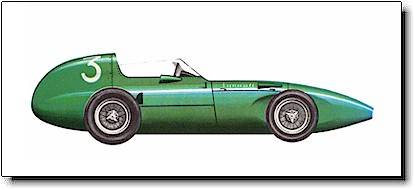Vanwall W1

Active: 1956
Team: Vanwall (Vandervell Products Ltd)
Since the end of World War II Formula 1, except for a brief period when Mercedes-Benz competed, has been dominated by a sea of Italian red. You had to drive an Alfa Romeo, Maserati or Ferrari if you were to have any hope of winning. The British Racing Motors V16 project, which was ruled by committee, was floundering. Tony Vandervell, the "ThinWall" bearing magnate was one of its early supporters. But he soon found himself tiring of the constant delays, brought about by infighting and red tape. He abruptly quit the project and chose to embark on his own course. His first step was to purchase some race cars from Ferrari which he christened the "ThinWall Specials". Being the prudent buyer he had his engineers strip down the cars whereupon it was noticed that many of the parts appeared worn. After some heated correspondence with Enzo Ferrari the situation was never duplicated. These heavily modified Ferrari's soon dominated British Formula Libre events. The experience from running these cars would soon be used against bigger fish. The next step for the new team would be in Formula 2 where he had a custom designed engine fitted to a Cooper built spaceframe chassis. These cars became the test bed for what ultimately would be a full scale Formula 1 team.

The first true Formula 1 Vanwall was designed by Cooper's resident designer, Owen Maddock but would be built in-house. The engine was based on a Norton design. Progress was slow and the team's transport driver suggested to the team manager that he had a friend who might be able to lend a hand. That friend's name was Colin Chapman. Derek Wootton, the driver, called his friend and said "Here Col ... you ought to come down to Acton - old man Vandervell needs help with his chassis" Chapman who was just starting his business and who up to that time worked only with sports cars jumped at the chance to work on a real Formula 1 car. On visiting the workshop he was looking over the car when "the old man" happened by and asked Chapman what he thought of the car. After Chapman answered it was clear to Vandervell that nothing short of starting over would appease the young engineer. Showing the decisiveness that had made him millions, he authorized Chapman to start a new design. For the body Chapman recommended an up and coming aerodynamicist named Frank Costin. Chapman's spaceframe design weighed in at 87.5 lbs. An important aspect of this car was that unlike BRM, Vandervell would use only the best components regardless of which country they originated in. The Costin designed body was striking in its teardrop shape and under body treatment. The car proved fast out of the box but suffered reliability problems. For 1957 Vandervell had two goals, improve reliability and hire the best drivers available - preferably British. The rear suspension was replaced with what would become known as a Chapman strut while the dampers were replaced with German units. Stirling Moss was available and a test was set up so that he could compare the leading British cars including a BRM, Connaught and Vanwall. He found the Vanwall to have the best potential and was promptly signed along with another driver who had made a name for himself driving the Connaught to victory at Syracuse, Tony Brooks. Stuart Lewis-Evens was eventually signed as the third driver. After more reliability problems victory was gained, fittingly at the British Grand Prix. At the Italian Grand Prix the Vanwalls qualified 1-2-3 with Moss scoring a victory on the Italians home ground. 1958 saw Moss in a Vanwall battle the Ferrari of Hawthorn for the World Championship. In the end he lost the title to Hawthorn by one point though he had won more races at 4 to Hawthorn's 1. As consolation Vanwall won the constructor's championship only to suffer tragically when Lewis-Evens crashed and died at the last race. Vandervell was heart-broken at the moment of Britain's greatest triumph. Facing mounting costs and poor health Vandervell decided to end Vanwall full-time racing operation at the end of the year. Even though its history was short lived the door was now open for other British constructors to challenge and beat the best of the continental powers.
